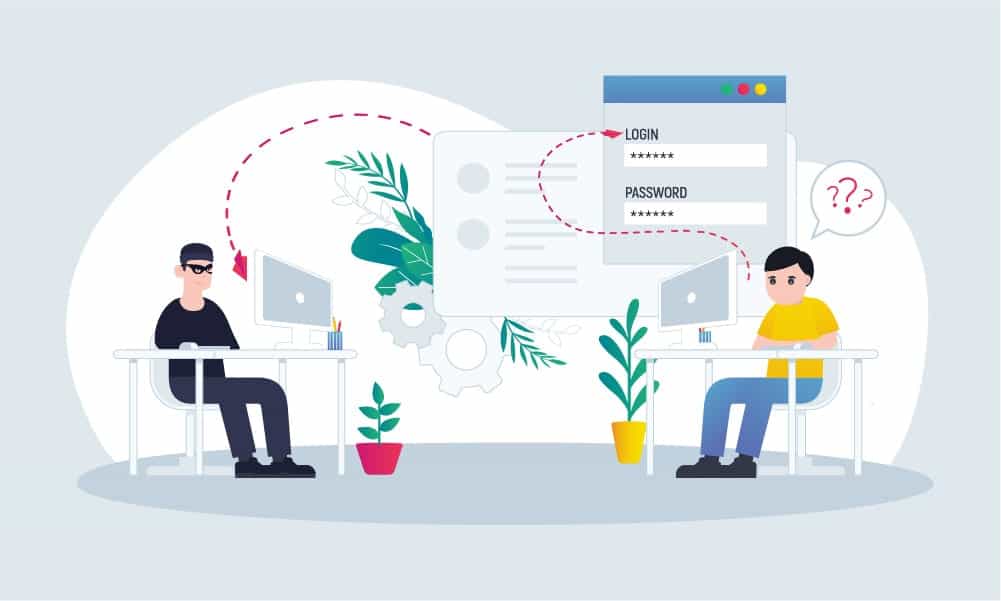In the digital world, where almost any service is online and requires data transfers, there is a need to be protected from data breaches and cybercrimes. How can society be protected from unwanted hacker activity? What are the web application security issues and security vulnerabilities in web applications that can give access to your private information?
Find out the answers to these questions and more in the following research about main web application vulnerabilities.
- Cybersecurity: Market Outlook
- What’s a Web App?
- App Security
- Injection
- Broken Authentication and Access Management
- Sensitive Data Exposure
- Broken Security Misconfiguration
- Cross-Site Scripting (XSS)
- Using components with known vulnerabilities
- Insufficient logging & monitoring
- Missing function level access control
- Cross-site request forgery
- Security Standards and Regulations
- TLS Protocol
- General data protection regulation
- CERT C coding standard
- Common weakness enumeration
- European Telecommunications Standards Institute
- Security technical implementation guide
- Final Thoughts
- Consider Inoxoft Expert Team to Create Protected Web Application
Cybersecurity: Market Outlook
Cybersecurity is one of the top issues that require specific attention. The number of cybercrimes, frauds, threats, risks, web application security issues, and vulnerabilities of organizations has increased due to technological progress. Technologies offer new capabilities, automate the processes in banking, retail, information technology, defense, and manufacturing industries, and trigger the increase of the global threat market as well. Thus, there is an urgent need for timely security measures. For this reason, the world’s cybersecurity market is going to grow in the following 6 years at a compound annual growth rate (CAGR) of 10%.
Among the cybercrimes, we can spot web app vulnerabilities that lead to data breaches. So, application security enhancement is an important issue to consider, as the application security vulnerability can be a cause of a lot of problems. All the potential measures are taken today to find, prevent, or fix possible web app security fraud and decrease all the manageable application security vulnerabilities. However, the measures taken are still not enough to ensure the digital data we transfer is safe. For example, in 2023 the average cost for businesses affected by a data breach in the U.S. was $9.4 million as Statista shows. And the numbers obtained are not the limit.
Based on the increase of the global threat landscape, it is crucial to understand what are the potential security risks considering web applications and how we can prevent security vulnerabilities in web applications.
What’s a Web App?
A web app is a software accessible from the computer browser, which runs on the web server. Most businesses use web apps to enhance their performance and sell their products. Usually, web apps work in 5 common steps:
- Step 1. User clicks on the preferable content to request a response from the webserver. It is done through any browser or web app UI.
- Step 2. The request is forwarded to the corresponding web app server.
- Step 3. Then the web processes the input data.
- Step 4. Web server sends a request to the data source and receives the requested data.
- Step 5. Web server generates a response and returns this response to the client, showing the needed data on the user display.
The following steps are carried out within a second and the user barely notices the ‘request-response’ procedure.
There’s an abundance of web-based applications we interact with daily. For example, one of them is all the Google Apps and Microsoft 365 apps.
Create a saas application that would meet all your business needs!
App Security
Application security covers all the measures taken to provide security to an application. According to the Open Web Application Security Project (OWASP), the most common security vulnerabilities may be:
- Injection
- Broken Authentication and Access Management
- Sensitive Data Exposure
- Broken Security Misconfiguration
- Cross-Site Scripting (XSS)
- Using Components with Known Vulnerabilities
- Insufficient Logging & Monitoring
Injection
Injection happens when untrustworthy data is sent together with the request to the interpreter. The latter is being tricked and processes the data with requested commands. This way, the fraudster might access the data even without proper authorization. Types of injections to look out for are SQL, NoSQL, OS Command, and LDAP. For instance, the vulnerabilities of NoSQL injection are in letting hackers inject code into commands for MongoDB databases or databases alike with no SQL query usage.
Broken Authentication and Access Management
The process of authentication requires the user to prove that he/she is the one accessing the web app (especially, in banking). Sometimes, the process is carried out incorrectly by the users, who might compromise the keys, passwords, or session tokens. This way, the thieves obtain the entry data and use it in their malicious intentions. Consider such authentication vulnerabilities as credential stuffing, brute force attacks, and weak passwords.
If there is no authentication restriction for the users or it is poorly managed, fraudsters can use the broken access to view the user’s account and everything in it. For instance, sensitive files, which can be modified, and the access rights that can be changed.
Sensitive Data Exposure
There are web apps or APIs that have weak protection of the sensitive content within them. E.g. weak cryptography and no encryption of financial, healthcare data, and personally identifiable information (PII). Cybercriminals overcome weak protection in no time and commit credit card fraud, steal identities or perform any other crimes based on the stolen data.
Identity theft is the number one type of data breach in the world. There were 1,387,615 complaints of identity theft reported to the Federal Trade Commission (FTC) in the United States. Bureau of Justice Statistics (BJS) defines identity theft as
- unauthorized/attempted use of an account by a third party
- unauthorized/attempted use of private information to create new accounts
- misuse of personal data for illegal purposes
Generally, since the occurrence of pandemics, the global identity theft risk increased by 29% and is expected to increase by 43% this year.
Broken Security Misconfiguration
Security misconfiguration is a common web app security problem these days. Usually, security misconfiguration is based on:
- insecure default configurations
- incomplete configurations
- open-source cloud storage
- misconfigured HTTP headers
- extensive error messages with sensitive content
As a result, every OS, framework, library, and apps should be securely configured and upgraded on time.
Cross-Site Scripting (XSS)
Cross-site scripting happens when you are redirected to a new web page with suspicious data. Unfortunately, this data is not validated. Here, XSS allows cybercriminals to steal user sessions by injecting client-side scripts and transferring users to malicious non-secure websites. Among the threats to be aware of are: reflected XSS, stored XSS, and DOM XSS. All these XSS are potential hazards to your sensitive data and private information.
Using components with known vulnerabilities
Web apps possess components that run with the same privileges as the application itself. E.g. frameworks, libraries, software modules, etc. Cyber hackers might take over one of these components and exploit it. The results of such exploitation presuppose cyber-attacks, data loss, or server management from the criminals’ side. Web apps with vulnerable components downgrade apps defenses and might let through almost any attack. So, be cautious while using
- outdated software
- apps with the inability to scan specific issues
- unfixable app frameworks
- non-updated compatibility of libraries
Insufficient logging & monitoring
Non-efficient log-ins and monitoring, non-effective incident response integration, make it possible for fraudsters to commit illegal actions as attack systems, extract sensitive data, expose it or destroy it. OWASP states that it takes about 200 days to spot a data breach. And, what’s most interesting, this is usually done by external parties.
Missing function level access control
It’s important to configure server-side authorization properly. If for some reason it is missing or damaged, your back-ends will be open to possible attacks. Front-end UIs usually can give admin access to data and other essential elements of the application, and front-end UIs often suffer from above-mentioned attacks. However, this problem can be easily solved. If you want to prevent unwanted access, you need to keep all server-side authentication active and configured. Only then you will be able to make sure there will be no dangerous invasion.
Cross-site request forgery
CSRF, or cross-site request forgeries makes authenticated users click a link which will enable forgeries to take control over users’ sessions. To do it, social engineering is being used. This is quite dangerous, because the attacker can change and steal important data using authenticated sessions. Cross-site tokens and applications that don’t have proper authentication suffer from cross-site forgeries the most. You have to be experienced in social engineering, otherwise you are also in danger of being a target of hackers. Yet, there are still ways to prevent these attacks. Cookies and secret tokens are really helpful if you need to tell a real request from a hostile one. If you utilize post requests and eliminate get requests, the chance of your data being stolen is much lower.
Security Standards and Regulations
To avoid the most common web vulnerabilities, multiple protocols and standards should be taken into account in web app development. For example:
TLS Protocol
Transport Layer Security (TLS) is the security protocol that aims to protect communication via the computer network. This protocol is cryptographic, which means it focuses on performing security-based functions within the app. Versions TLS protocols are used in emails, instant messaging, and voice-over IP. However, the most common protocol that you’ve probably seen is the HTTPS security layer that is visible to the public through the browser search window. Here, TLS secures a website and web browser traffic and encodes it with the HTTP protocol transforming it into HTTPS protocol.
The main focus of the TLS protocol is to secure communication processes between two or more web applications. If the protocol secures your app, it possesses the following properties:
- Privacy. The data transmitted is encrypted by the symmetric-key algorithm. The keys of the algorithm are generated at the start of the session and are called ‘the shared secret’. So, the encrypted keys and security algorithm settle on the common shared secret connection, which is protected to such an extent that no one can obtain it, even with the help of injection attacks.
- Authentication. The connection of user communication is encrypted by public-key cryptography. Mainly, the kind of authentication is requested by the server and is optional for the client.
- Reliability. Every message transmitted via the internet is secured by an integrity check and message authentication code to prevent possible hacker attacks during transmission.
General data protection regulation
General Data Protection Regulation (GDPR) is a European legislation #679 of 27 April 2016 that aims to protect personal data, its processing, transmission, and usage. The Directive 95/46/EC proposes personal data processing requirements within the European Economic Area (EEA) and applies to enterprises not taking account of their location, citizenship, or place of residence as long as the data is being processed within the EEA.
Data protection regulation is carried out with the help of:
- Appropriate technical support
- Organizational measures (internal controls and operations, e.g. audit)
- Considerably designed and built business processes
- Pseudonymization
- Anonymization
- Enclosed (private) datasets with information
- 6 data processing laws (consent, contract, public task, vital interest, legitimate interest, legal requirement)
- Minimal personal data interference by employers, employees, customers or third parties
- Data protection officer, who does the audit
- Reporting of data breaches and other data-related issues
CERT C coding standard
Cert C Coding standard is the standard for software coding, which is based on the C-programming language and aims at software safety, security, and reliability improvement. The guidelines of the document are cross-referenced and include other security standards and laws.
Common weakness enumeration
Common Weakness Enumeration is a National Cybersecurity FFRDC sponsored project in the U.S. CWE is a system of categories to search for software weaknesses and design specific tools that could find and fix these weaknesses. CWE has more than 600 categories. What’s more, it includes classes for buffer overflows, path/directory tree traversal errors, race conditions, cross-site scripting, hard-coded passwords, and insecure random numbers.
European Telecommunications Standards Institute
European Telecommunications Standards Institute is a non-profit organization that has its specific standards for the informational and communication industries. ETSI aims to support global tech standards (both in the development and testing phases) to produce apps, services, and ICT-enabled systems. All the standards ESTI produces are up-to-date, published annually (up to 1800 per year), and can be downloaded from the website.
Security technical implementation guide
Security Technical Implementation Guide (STIG) is a standard for the configuration of a particular product and its cybersecurity requirements. It is a methodology that enhances security in web applications (software security) as well as reduces vulnerabilities in hardware, logical and physical architectures. To add, STIG has a full description of network-based attack minimization and preventive measures to ensure the hacker will not be able to access the system.
And this list is quite extensive. Also, web application security vulnerabilities can be eliminated following the Health Insurance Portability and Accountability Act (HIPAA), Gramm-Leach-Bliley Act (GLBA), NIST Special Publication 800-53, PCI Data Security Standard (PCI DSS), Sarbanes-Oxley Act (SOX), ISO/IEC 27034-1:2011 and others based on the specificity of web application developed (technologies and tools) and, in some cases, based on the country regulations for every country has its software development policies.
Final Thoughts
In the digital world of today, web app security is an essential feature. You can always find vulnerabilities in a website, but it’s better not to practice security deviations and be protected from data breaches or other security fraud. Security is not only important for the users, who’d like to keep their data on the safe side, but also for the software development vendors, who’d like to meet user security demand and become a trustworthy service provider on the custom and global market.
In case you’d like to know more about web app security and how to achieve the best level of protection, contact us today to get an expert’s opinion.
Consider Inoxoft Expert Team to Create Protected Web Application
The world’s best software services are offered by Inoxoft, a global software development firm. Our devoted team offers automated operations, first-rate customer service, and support. We can help you create the best web application and avoid common web application vulnerabilities. You may rest assured that all of your wants and business requirements will be met.
Inoxoft provides custom web development services and mobile app development services. We will tell you how to avoid web application security vulnerabilities and will help you make web application vulnerabilities list, so you can be aware of all the possible issues that could occur. With the help of Inoxoft web application security risks are no longer relevant, as our company guarantees you full security and personalized experience.
If you are looking for a devoted partner to help you create a protected web application, Inoxoft is the ultimate option for you! You will be completely satisfied not only with your user experience but also with the final product. Contact us and create web application of your dreams!
Frequently Asked Questions
How can I avoid application security vulnerability?
To avoid application security vulnerability you have to implement proper logging, use real-time security monitoring and protection, encrypt sensitive information etc.
What are main web application security issues?
Main web application security issues are injection, broken authentication and access management, sensitive data exposure, broken security misconfiguration, insufficient logging & monitoring and many other things.
What are the most serious web application security risks?
Top three most common application security risks are cryptographic failures, broken access control and injection. If you want to know more, read the article!














